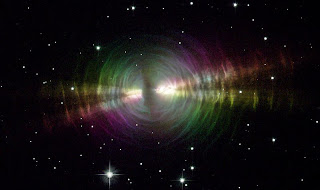The protoplanetary nebula (PPN) is an interesting variant on most nebulae. This one is actually part of a specific star's stellar evolution. As the same may suggest, it is also a precursor to the planetary nebulae.
During the stellar evolution, the star releases a huge amount of hydrogen into the surrounding sky. The hydrogen, as it is being released, forms a sort of shell around the star. Once this is complete, the PPN phase is in effect. The star core of the PPN fuels the light, creating the fantastically bright visuals that PPN are famous for. Attached below is the Egg Nebula, which is part of the constellation Cygnus, and is a PPN.
Stellar winds are responsible for the symmetrical shape of these nebulae. They remain this way until the core temperature of the star reaches about 30,000 degrees Kelvin. AT this point, the heat ionizes the hydrogen cloud, and the PPN becomes a planetary nebulae. Note the distinct symmetrical shape of the Red Rectangle nebula below.


No comments:
Post a Comment